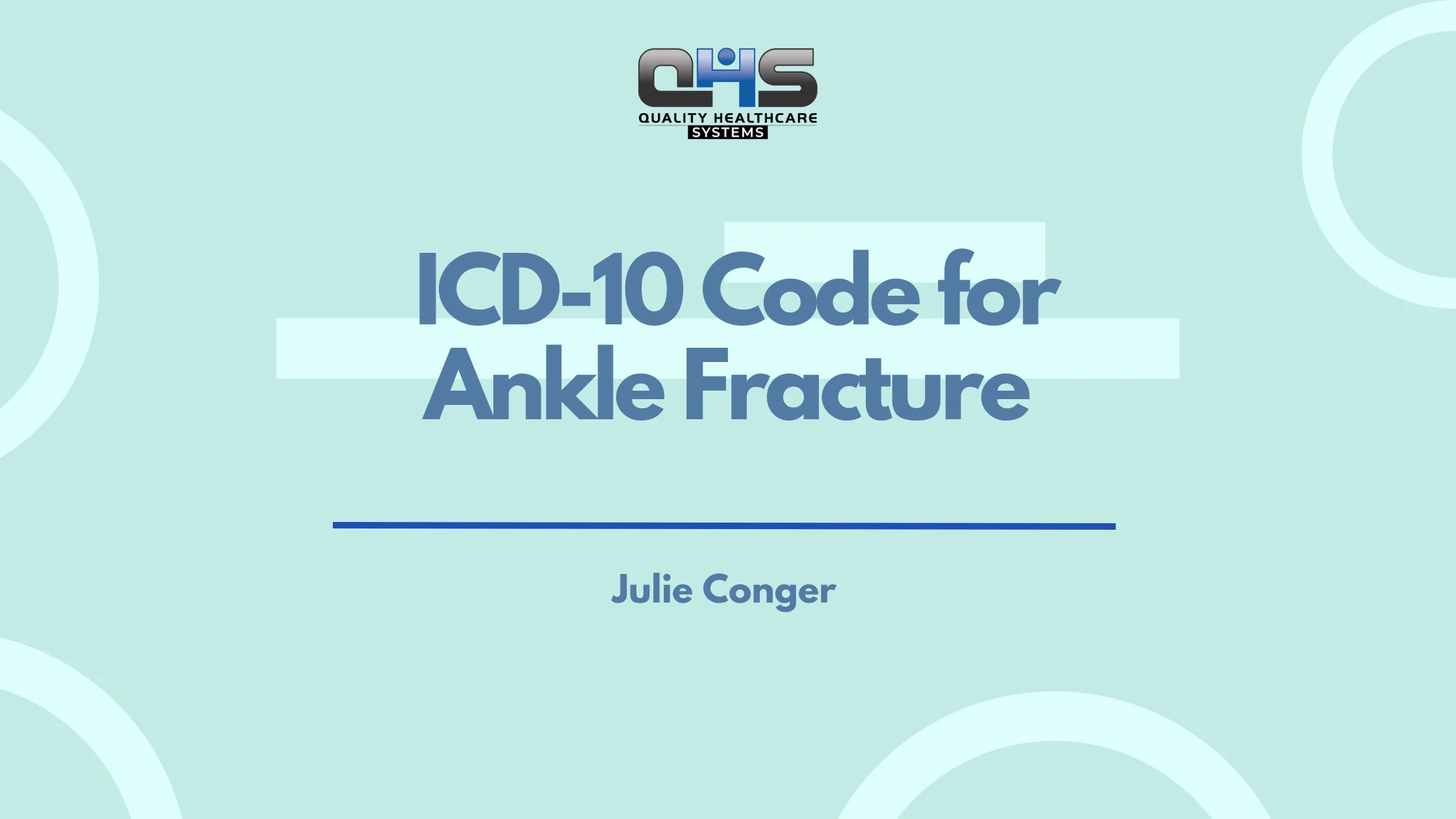Ankle fractures are among the most frequently reported orthopedic injuries, and accurate ICD-10 coding is crucial for proper diagnosis, treatment, and billing. Whether you’re a provider or billing specialist, understanding the ICD-10 codes for Ankle fracture and guidelines for ankle fractures ensures smooth insurance claims and compliant documentation from the initial encounter to recovery.
What is the ICD-10 Code for Ankle Fracture?
Ankle fractures are common orthopedic injuries that range from simple cracks in the bone to complex breaks involving multiple structures. Accurate diagnosis, documentation, and billing for these fractures are critical for effective treatment and reimbursement. The ICD-10 code system allows healthcare providers to capture the location, severity, and complexity of ankle fractures for precise clinical and administrative purposes.
The ICD-10 codes for ankle fractures fall under the category S82, specifically addressing different fracture types and locations. The most commonly used base codes include:
-
S82.891A – Other fracture of right lower leg, initial encounter for closed fracture
-
S82.892A – Other fracture of left lower leg, initial encounter for closed fracture
-
S82.849A – Nondisplaced bimalleolar fracture of unspecified lower leg, initial encounter for closed fracture
-
S82.831A – Displaced trimalleolar fracture of right lower leg, initial encounter for closed fracture
Each ICD-10 code must also include a 7th character to specify the episode of care:
-
A for initial encounter
-
D for subsequent encounter
-
S for sequela
Correct selection of ICD-10 codes ensures accurate claim processing and supports clinical decision-making.
Other Related ICD-10 Codes for Ankle Fractures and Orthopedic Injuries
| Condition | ICD-10 Code | Description |
|---|---|---|
| Displaced lateral malleolar fracture | S82.64XA | Right side, closed fracture |
| Nondisplaced medial malleolar fracture | S82.55XA | Left side, initial encounter |
| Open trimalleolar fracture | S82.831B | Right side, initial encounter, open fracture |
| Pathologic ankle fracture | M84.47XA | Fracture due to underlying bone condition |
Who is at Risk for Ankle Fractures?
Ankle fractures can occur in people of all ages but are more common in individuals who experience specific risk factors. Understanding these factors helps in both preventing injuries and properly coding for them under ICD-10 guidelines.
High-Risk Groups for Sports-Related Ankle Fractures
People who engage in high-impact sports are particularly vulnerable to sports-related ankle fractures. Whether participating in activities like basketball, soccer, or running, the risk of athletic injury ICD-10 codes related to ankle fractures rises due to sudden twists, high jumps, or contact injuries.
Fractures in athletes are often classified as lateral malleolus fractures or medial malleolus fractures ICD-10, depending on the location of the break. If there is displacement, displaced ankle fracture ICD-10 is used for billing.
Osteoporosis and Low Bone Density
Individuals with osteoporosis or low bone density face an increased risk of fragility fractures ICD-10. For these individuals, even minor trauma or a simple fall can lead to serious fractures. Ankle fractures related to osteoporosis are often classified as closed ankle fractures ICD-10 if no open wound is involved.
Older Adults with Balance Issues
Older adults are particularly prone to geriatric fracture coding due to balance problems, decreased bone density, and slower reflexes. In many cases, ankle fractures in the elderly occur when a fall happens on uneven terrain or during simple household tasks. The ICD-10 coding for ankle injuries in seniors often includes ankle fracture diagnosis coding that accounts for additional complications like comorbidities (e.g., diabetes or neuropathy).
In these cases, ankle injury ICD-10 codes by location such as trimalleolar ankle fracture ICD-10 might be used to specify the injury type.
Workers in Physically Demanding Environments
People working in physically demanding jobs are at risk of workplace ankle injury or occupational fracture ICD-10 coding when performing tasks that require heavy lifting, long hours of standing, or working in hazardous conditions.
Falls from height, carrying heavy objects, or accidents on the job can lead to complex injuries like bimalleolar ankle fractures ICD-10 or open ankle fracture ICD-10, requiring more detailed coding for treatment and reimbursement purposes.
Trauma from Vehicle Accidents
Car accidents or vehicular collisions are a leading cause of traumatic orthopedic coding when they result in an ankle injury. Whether due to blunt force trauma or direct impact, the injury can be classified under specific ICD-10 codes such as trimalleolar ankle fracture ICD-10 if multiple bones are involved.
ICD-10 coding for such injuries can be complex as it may require additional codes for complications such as internal bleeding or fractures of other body parts.
Risk from Improper Footwear
Ankle injuries due to improper footwear are also a common risk factor. Wearing shoes that don’t provide adequate support or that increase the likelihood of slips can lead to falls and fractures. Such injuries are often classified as shoe-related ankle injuries, which are tracked under unstable footwear fracture codes for documentation and billing purposes.
Neuropathy and Nerve-Related Injury Risks
For individuals with neuropathy, including those with diabetes, the risk of an ankle fracture can increase significantly. Since neuropathy affects sensation and motor skills, it can lead to falls or trauma without the individual being fully aware of the potential injury. Neuropathy-related injury codes are essential in these cases, helping healthcare providers track and properly document injuries.
Ankle fractures caused by neuropathy could be classified under complex ICD-10 codes, including ankle fracture comorbidities and complex ankle fracture coding, to reflect the multifactorial nature of the injury.
ICD-10 Codes for Ankle Fractures and Related Conditions
| ICD-10 Chapter | Code | Condition | Clinical Relevance |
|---|---|---|---|
| Injury & Poisoning (Chapter 19) | S82.841A | Nondisplaced bimalleolar fracture of right lower leg | Used for initial care of stable, non-displaced fractures |
| Injury & Poisoning (Chapter 19) | S82.832A | Displaced trimalleolar fracture of left lower leg | Applied when all three malleoli are fractured |
| Injury & Poisoning (Chapter 19) | S82.849A | Unspecified lower leg fracture | Used when the fracture pattern is not clearly defined |
What are the Causes of Ankle Fractures?
Understanding the cause of an ankle fracture is essential for diagnosis, treatment, and billing accuracy.
-
Trauma – Direct impacts from falls, auto accidents, or sports collisions.
-
Twisting injuries – Common in basketball, soccer, or running, where foot inversion leads to bone breaks.
-
Stress fractures – Caused by repetitive overuse in athletes or military recruits.
-
Osteoporosis – Weakened bones are more prone to fractures, even with minimal impact.
-
High-energy accidents – Such as industrial incidents or falls from height, often requiring surgical intervention.
What Are the Symptoms of Ankle Fractures?
Ankle fractures often present with immediate and localized symptoms, varying based on the type and severity of the fracture. Recognizing these symptoms early is crucial for proper diagnosis, treatment, and documentation, especially when it comes to accurate ICD-10 coding for ankle fractures.
Severe Pain and Swelling Around the Malleoli
One of the most common ankle fracture symptoms is severe pain, especially around the malleoli (the bony prominences on either side of the ankle). This pain is usually acute and intensifies with movement or pressure. Swelling around the ankle occurs due to inflammation, with the area often becoming visibly larger.
ICD-10 codes for lateral malleolus fractures or medial malleolus fractures ICD-10 are commonly used to identify the specific location of the injury.
Bruising or Discoloration at the Injury Site
Bruising or discoloration is another characteristic symptom of ankle fractures. This occurs due to internal bleeding at the site of injury, often within the tissues around the fracture. As the blood pools beneath the skin, it causes visible bruising. In more severe cases, discoloration of the foot and ankle may extend over a large area.
Deformity or Misalignment in Displaced or Compound Fractures
In cases of displaced ankle fractures ICD-10, the bones may shift out of their normal alignment, leading to visible deformity. This misalignment may be immediately apparent, particularly in open ankle fractures ICD-10 where the bone breaks through the skin, resulting in compound fractures.
Proper classification using ICD-10 ensures precise tracking of the injury and related treatment. Displaced ankle fractures often require surgical intervention, and accurate coding helps facilitate insurance billing and reimbursement.
Inability to Bear Weight on the Affected Foot
A hallmark symptom of an ankle fracture is the inability to bear weight on the injured foot. This symptom typically appears immediately following the injury and is persistent until the fracture is treated. Fractures with severe pain can make it difficult for the patient to walk or stand.
In many cases, ICD-10 coding for ankle injuries includes specifying whether the injury results in non-weight bearing and impacts the patient’s mobility.
Tenderness to Touch Along the Lateral or Medial Malleolus
Tenderness to touch is a common symptom of both lateral malleolus fractures and medial malleolus fractures ICD-10. When palpating the area around the malleolus, patients may report significant discomfort, particularly if the bone is fractured. Healthcare professionals often use tenderness as an indicator when determining the type and location of the fracture for accurate coding.
Open Wounds in Compound Fractures
In cases of compound fractures, where the bone breaks through the skin, open wounds become a serious concern. These types of fractures require immediate attention to prevent infection and other complications. ICD-10 codes such as S82.XXXB or S82.XXXA may be used to document these open ankle fractures.
Proper documentation of these symptoms is vital for accurate ICD-10 coding for ankle fractures, which plays a crucial role in the diagnosis, treatment, and reimbursement process. By using the appropriate codes such as displaced ankle fracture ICD-10, closed ankle fractures ICD-10, or compound fractures ICD-10, healthcare providers can ensure comprehensive care and proper insurance reimbursement.
How is an Ankle Fracture Diagnosed?
Diagnosing an ankle fracture requires a systematic clinical approach supported by imaging:
-
Physical Examination – Checks for tenderness, swelling, range of motion, and deformity
-
X-rays – Primary imaging tool for identifying fracture type and displacement
-
CT scan – Used for complex or comminuted fractures
-
MRI – Helpful in identifying associated soft tissue injuries
-
Ottawa Ankle Rules – Guidelines to determine whether imaging is needed
Diagnosis accuracy ensures that the correct ICD-10 code is assigned and that CPT codes for imaging and procedures (e.g., CPT 73590 – X-ray of ankle) are appropriately linked.
What are the Treatment Options for Ankle Fractures?
Treatment depends on the type and severity of the fracture:
| Condition | Treatment | Example |
|---|---|---|
| Non-displaced fracture (S82.841A) | Immobilization | Walking boot, cast, crutches |
| Displaced fracture (S82.831A) | Closed reduction and casting | Realignment under sedation |
| Complex fractures | Open Reduction Internal Fixation (ORIF) | CPT 27766 – Surgical repair |
| Open fractures | Surgical debridement + fixation | Requires layered repair and antibiotics |
Pain management may involve NSAIDs or opioids. Follow-up includes physiotherapy for restoring mobility and strength.
Lifestyle Modifications and Recovery for Ankle Fracture Patients
Recovery from an ankle fracture requires adherence to medical advice:
-
Weight-bearing restrictions – Use of crutches or scooters to avoid pressure on the healing joint
-
Elevation and ice application – To reduce inflammation
-
Physical therapy – To restore range of motion and prevent stiffness
-
Gradual activity resumption – Avoiding reinjury through guided movement
Compliance with post-operative or post-immobilization instructions is crucial for full recovery. Monitoring progress during follow-up visits may also impact code selection (initial vs. subsequent encounters).
How Does the ICD-10 Code for Ankle Fracture Impact Medical Billing?
Correct ICD-10 coding for ankle fractures is essential for:
-
Submitting accurate claims to Medicare and private insurers
-
Linking diagnosis with procedures like imaging or surgery
-
Preventing claim denials due to mismatched codes or missing 7th characters
-
Ensuring compliance with CMS and payer-specific documentation standards
At QHS Health, our coding experts ensure that all required details are captured to minimize rejections and support optimal reimbursements.
ICD-10 Coding Guidelines for Ankle Fracture (S82 Series)
Proper coding for ankle fractures ensures accurate diagnosis, treatment, and insurance reimbursement. The ICD-10 coding system for ankle fractures (S82 series) has specific rules for documentation, which must be followed to ensure compliance and avoid billing discrepancies.
1. Full 7-Character Codes for Encounter Stage
When coding for ankle fractures, use the complete 7-character ICD-10 code to indicate the encounter stage. The 7th character designates whether the fracture is initial, subsequent, or sequela (e.g., S82.831A for the initial encounter of a trimalleolar fracture on the right side). This is critical for distinguishing between treatment phases.
2. Documenting Open vs. Closed Fractures
For accurate ICD-10 coding for ankle fractures, document whether the fracture is open or closed. Open fractures involve the bone penetrating through the skin, while closed fractures do not. This distinction influences both the treatment and the billing process, and should be reflected in the coding system.
3. Displaced vs. Nondisplaced Fractures
The displacement status of the fracture also needs to be specified. A displaced fracture means the bone fragments are misaligned, requiring realignment or surgery, while a nondisplaced fracture means the bone remains in its normal position. Different codes are used depending on the fracture type (e.g., S82.849D for a subsequent encounter of a bimalleolar fracture, unspecified side).
4. Laterality (Right, Left, or Unspecified)
ICD-10 codes for ankle fractures require laterality — specifying whether the injury is on the right or left side of the body. If this is not documented, the code should be marked as unspecified. Laterality ensures accurate diagnosis and billing, preventing confusion or mistakes in treatment and reimbursement.
5. Pairing Diagnosis Codes with CPT Codes
For accurate and comprehensive billing, diagnosis codes for ankle fractures should be paired with appropriate CPT (Current Procedural Terminology) codes. This may include codes for imaging, reduction procedures, or surgical repair. For example:
-
CPT 27766 – Open reduction and internal fixation (ORIF) of ankle fracture
-
CPT 73590 – X-ray of ankle (2 or more views)
These codes assist in documenting the procedure performed and allow for proper reimbursement for services rendered.
6. Follow Official CMS and ICD-10-CM Guidelines
Always adhere to the official CMS (Centers for Medicare & Medicaid Services) and ICD-10-CM (Clinical Modification) guidelines. These guidelines outline the official instructions for coding fractures and trauma cases, ensuring compliance and minimizing billing errors. Failure to comply with these guidelines can lead to billing discrepancies and claim denials.
ICD-10 Coding for Ankle Fractures: Insurance Billing, Guidelines & Classification
When billing for ankle fractures, it’s essential to consider diagnosis coding, procedure coding, and specific billing rules for the insurance process. Accurate coding ensures the correct payment for treatment and diagnostic procedures.
Key ICD-10 Diagnosis Codes for Ankle Fractures:
-
S82.831A – Initial encounter for trimalleolar fracture, displaced, right side
-
S82.849D – Subsequent encounter for bimalleolar fracture, unspecified side
-
S82.XXXA – Initial encounter for lateral malleolus fracture
These diagnosis codes should be used based on the specific type of fracture and the stage of the encounter (initial, subsequent, or sequela).
Procedure Codes for Ankle Fractures:
-
CPT 27766 – Open reduction and internal fixation (ORIF) of ankle fractures
-
CPT 73590 – Ankle X-ray, 2 or more views
These codes are used for procedural documentation, helping insurance companies understand what treatments were provided.
Key Billing Considerations for Ankle Fracture:
Link Diagnosis and Procedure Codes
Ensure that the diagnosis codes are appropriately linked to the corresponding procedure codes. For example, if a patient receives an ORIF for an ankle fracture, the corresponding ICD-10 diagnosis for the ankle fracture (e.g., S82.831A) should be linked with the CPT code for the procedure (e.g., CPT 27766).
Documenting Traumatic vs. Pathologic Fractures
In some cases, ankle fractures may be classified as traumatic or pathologic (due to underlying conditions like osteoporosis). Proper documentation helps in determining whether the fracture resulted from a traumatic event or a disease process, which impacts both treatment and billing.
Modifiers for Bilateral or Staged Procedures
If the procedure is bilateral (on both sides) or staged (performed in multiple sessions), modifiers should be applied to the CPT codes. For instance, use modifier 50 for bilateral procedures to ensure the insurance company processes both sides as separate claims.
Check Payer Rules for Prior Authorization
Before performing surgical procedures for ankle fractures, check the payer’s guidelines for prior authorization, especially when surgery is involved. Some insurance companies require pre-approval for surgical interventions like ORIF or open reduction of ankle fractures.
Related Posts: ICD-10 Codes for Chest Pain | ICD-10 Codes for Dysuria
Pediatric and Adult ICD-10 Code for Ankle Fracture
Pediatric Cases:
Children often experience growth plate fractures, which require separate coding:
-
S89.021A – Salter-Harris Type I fracture of distal tibia, initial
-
S82.899A – Other specified fractures in lower leg, pediatric classification
Ensure documentation includes growth plate involvement and treatment plan to select the most accurate ICD-10 code.
Adult Cases:
Standard S82.XXX codes apply with proper documentation of:
-
Type (displaced/nondisplaced)
-
Side (right/left)
-
Encounter (initial/subsequent/sequela)
Ankle Fracture ICD-10 Code With Complications
| Complication | ICD-10 Code |
|---|---|
| Nonunion of fracture | M84.47XA |
| Malunion of ankle fracture | M84.47XD |
| Post-traumatic arthritis | M19.171 |
| Compartment syndrome | T79.A1XA |
Chronic or Recurrent Ankle Fracture Classification
For chronic cases or complications from previous fractures, include codes such as:
-
M84.47XD – Nonunion, right lower leg, subsequent encounter
-
Z87.81 – Personal history of traumatic fracture
-
Z96.651 – Presence of orthopedic implant (if ORIF was done)
Final Thoughts
Navigating the complexities of ICD-10 coding for ankle fractures can be challenging, but QHS Health is here to help. We specialize in accurate fracture code selection, ensuring that the correct 7th characters are used to denote the encounter stage, whether initial, subsequent, or sequela. Our team ensures full compliance with CMS orthopedic coding standards, reducing billing discrepancies and ensuring your practice meets all regulatory requirements.
Whether you’re handling routine fractures or complex cases that involve surgeries and follow-up treatments, we provide tailored support to make your billing process more efficient. Contact us today to optimize your billing for ankle fractures and other musculoskeletal conditions, and experience a smoother, more reliable billing process with QHS Health.
Read: How Insurance Claims Billing for Prosthetic Devices Works






